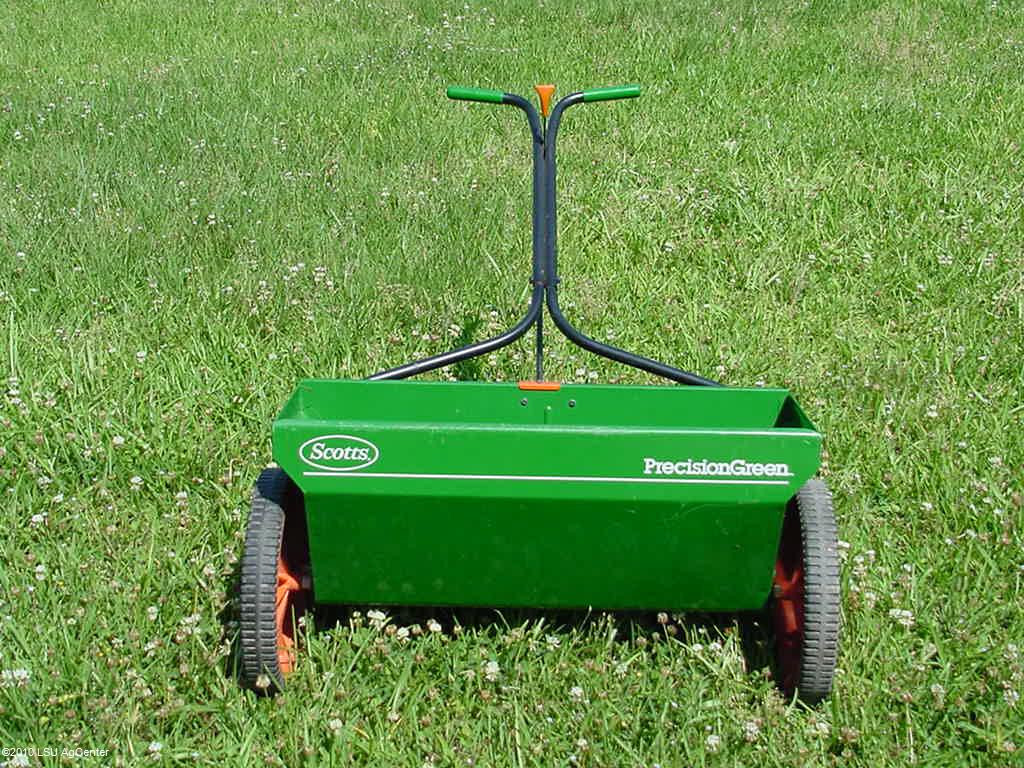Swath Width and Distribution Pattern
For a drop spreader, the swath width is the measurement of the bottom of the hopper. The pattern should be uniform across the swath. Using the orifice setting for your spreader from the pesticide label instructions, make a short test run on a clean paved surface where you will be able to see the distribution pattern. If it is not even, you may need to clean the openings in the bottom of the hopper or correct the agitator operation. Remove granules from the paved surface.
Three Ways to Measure the Application Rate
Method 1 – Catch Pan
Attach a catch pan or small section of gutter with end caps (see photo in upper right) to the bottom of the hopper. It should be wide enough to capture all the granules and attached in a way that does not interfere with the shut-off bar or rate-control linkage.
Step 1 — Measure a straight test course that will give the equivalent of 100 square feet. For example, a drop spreader with a 3-foot swath width should cover a course 33 feet long (100 / 3 = 33). A spreader with a 2-foot swath width should cover a 50-foot course (100 / 2 = 50).
Step 2 — Fill the hopper half full with product and select a gate setting based on the pesticide label or spreader manual.
Step 3 — Push the spreader over the test course. Begin walking at the desired speed before you cross the starting line. Turn on the flow of material as you cross the starting line. Turn it off when you cross the finish line. Weigh the amount of material captured in the pan. Convert ounces or grams to pounds.
Step 4 — To determine the spreader application rate in pounds per 1,000 square feet, multiply the weight by 10.
Step 5 — Compare the spreader application rate to the pesticide label rate. If the spreader rate is not within 10 percent of the label rate, adjust the gate opening and repeat Steps 3 and 4 until it is. Note that even small changes in the settings can result in large changes in the flow of material.
Example
Labeled rate: 2 lbs. product per 1,000 sq. ft.
Spreader swath width: 3 ft. Test course length = 33 ft. (100 / 3)
Amount collected in catch pan: 120 grams or 0.26 lbs.
(120 grams / 454 grams per lb. = 0.26 lbs.)
Spreader rate per 1,000 sq. ft.: 0.26 lbs. x 10 = 2.6 lbs.
Adjust spreader by reducing gate opening until the rate falls between 1.8 and 2.2 lbs. (2.0 lbs. ± 10 percent).
Method 2 – Sweep and Weigh
Instead of catching the material during application to the test course, you can lay out a course on a concrete surface or plastic sheet. Sweep up and weigh the material.
Method 3 – Weigh Before and After
Place a known weight of granules in the hopper, conduct a calibration run over the test area, and reweigh the granules remaining in the spreader. The difference is the amount applied.
Example
Put 2 pounds of granules in a drop spreader that has a swath width of 2 feet. After applying the product to a 50-foot test course, you recover 1.75 pounds of granules from the spreader. The calibrated rate is 0.25 pounds per 100 sq. ft., or 2.5 lbs. per 1,000 sq. ft.